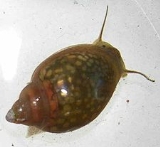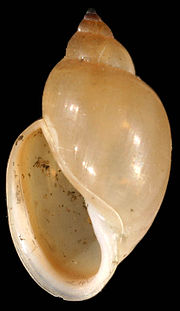
Physella acuta
Encyclopedia
Physella acuta, common name the European physa, is a species
of small, left-handed or sinistral
, air-breathing freshwater snail
, an aquatic
gastropod mollusk in the family Physidae.
 Snails in the family Physidae have shells
Snails in the family Physidae have shells
that are sinistral, which means that if the shell is held with the aperture
facing the observer and the spire
pointing up, then the aperture is on the left-hand side.
The shells of Physella species have a long and large aperture, a pointed spire, and no operculum. The shells are thin and corneous and rather transparent.
Physella acuta is the common species, which has invaded practically all fresh waters of the world, and is common in all of North America and Europe. The species seems to have first spread through Mediterranean regions and then more slowly into northern Europe.
The distribution also includes Mediterranean regions and Africa
.
, New Jersey
, and Virginia
. The initial introduction in the United States was probably from aquarium release, aka "aquarium dumping".
Physella acuta is frequently found in anthropogenic reservoirs, occurring in warm water discharges from power stations and in some rivers, but very rarely and not numerously in clay pit ponds. It can survive well under temporary harsh conditions (extreme temperature and water pollution
), as long as they are short-lived.
.
While Physella acuta forages mainly on epiphytic vegetation and on the macrophytes, other gastropods (Planorbis planorbis
, Radix ovata) exploit the algal cover or phytobentos on the bottom. Therefore competition between Physella acuta and other gastropods appears to be minimal.
in the Danube River.
Species
In biology, a species is one of the basic units of biological classification and a taxonomic rank. A species is often defined as a group of organisms capable of interbreeding and producing fertile offspring. While in many cases this definition is adequate, more precise or differing measures are...
of small, left-handed or sinistral
Sinistral
Sinistral and dextral are scientific terms that describe chirality or relative direction in a number of disciplines.The terms are derived from the Latin words for “left” and “right” ....
, air-breathing freshwater snail
Freshwater snail
A freshwater snail is one kind of freshwater mollusc, the other kind being freshwater clams and mussels, i.e. freshwater bivalves. Specifically a freshwater snail is a gastropod that lives in a watery non-marine habitat. The majority of freshwater gastropods have a shell, with very few exceptions....
, an aquatic
Aquatic animal
An aquatic animal is an animal, either vertebrate or invertebrate, which lives in water for most or all of its life. It may breathe air or extract its oxygen from that dissolved in water through specialised organs called gills, or directly through its skin. Natural environments and the animals that...
gastropod mollusk in the family Physidae.
Shell description

Gastropod shell
The gastropod shell is a shell which is part of the body of a gastropod or snail, one kind of mollusc. The gastropod shell is an external skeleton or exoskeleton, which serves not only for muscle attachment, but also for protection from predators and from mechanical damage...
that are sinistral, which means that if the shell is held with the aperture
Aperture (mollusc)
The aperture is an opening in certain kinds of mollusc shells: it is the main opening of the shell, where part of the body of the animal emerges for locomotion, feeding, etc....
facing the observer and the spire
Spire (mollusc)
A spire is a descriptive term for part of the coiled shell of mollusks. The word is a convenient aid in describing shells, but it does not refer to a very precise part of shell anatomy: the spire consists of all of the whorls except for the body whorl...
pointing up, then the aperture is on the left-hand side.
The shells of Physella species have a long and large aperture, a pointed spire, and no operculum. The shells are thin and corneous and rather transparent.
Distribution
It was thought that indigenous distribution of Physella acuta is Mediterranean. But if Physella heterostropha is a synonym, then as its indigenous distribution is considered as North-American.Physella acuta is the common species, which has invaded practically all fresh waters of the world, and is common in all of North America and Europe. The species seems to have first spread through Mediterranean regions and then more slowly into northern Europe.
In Europe
- Croatia
- Czech Republic - not evaluated (NE)
- Germany
- Netherlands
- Pripyat RiverPripyat RiverThe Pripyat River or Prypiat River is a river in Eastern Europe, approximately long. It flows east through Ukraine, Belarus, and Ukraine again, draining into the Dnieper....
since 1983 and in Neman RiverNeman RiverNeman or Niemen or Nemunas, is a major Eastern European river rising in Belarus and flowing through Lithuania before draining into the Curonian Lagoon and then into the Baltic Sea at Klaipėda. It is the northern border between Lithuania and Russia's Kaliningrad Oblast in its lower reaches...
basin in BelarusBelarusBelarus , officially the Republic of Belarus, is a landlocked country in Eastern Europe, bordered clockwise by Russia to the northeast, Ukraine to the south, Poland to the west, and Lithuania and Latvia to the northwest. Its capital is Minsk; other major cities include Brest, Grodno , Gomel ,...
since 2007 - and others
The distribution also includes Mediterranean regions and Africa
Africa
Africa is the world's second largest and second most populous continent, after Asia. At about 30.2 million km² including adjacent islands, it covers 6% of the Earth's total surface area and 20.4% of the total land area...
.
In America
The distribution includes the United States: MarylandMaryland
Maryland is a U.S. state located in the Mid Atlantic region of the United States, bordering Virginia, West Virginia, and the District of Columbia to its south and west; Pennsylvania to its north; and Delaware to its east...
, New Jersey
New Jersey
New Jersey is a state in the Northeastern and Middle Atlantic regions of the United States. , its population was 8,791,894. It is bordered on the north and east by the state of New York, on the southeast and south by the Atlantic Ocean, on the west by Pennsylvania and on the southwest by Delaware...
, and Virginia
Virginia
The Commonwealth of Virginia , is a U.S. state on the Atlantic Coast of the Southern United States. Virginia is nicknamed the "Old Dominion" and sometimes the "Mother of Presidents" after the eight U.S. presidents born there...
. The initial introduction in the United States was probably from aquarium release, aka "aquarium dumping".
- Cuba - native, also with Tarebia graniferaTarebia graniferaTarebia granifera, common name in the aquarium industry the quilted melania, is a species of freshwater snail with an operculum, an aquatic gastropod mollusk in the family Thiaridae...
it is the most common freshwater snail in Cuba
Habitat
This species lives in freshwater rivers, streams, lakes, ponds, and swamps.Physella acuta is frequently found in anthropogenic reservoirs, occurring in warm water discharges from power stations and in some rivers, but very rarely and not numerously in clay pit ponds. It can survive well under temporary harsh conditions (extreme temperature and water pollution
Water pollution
Water pollution is the contamination of water bodies . Water pollution occurs when pollutants are discharged directly or indirectly into water bodies without adequate treatment to remove harmful compounds....
), as long as they are short-lived.
Feeding habits
These snails eat dead plant and animal matter and various other detritusDetritus
Detritus is a biological term used to describe dead or waste organic material.Detritus may also refer to:* Detritus , a geological term used to describe the particles of rock produced by weathering...
.
While Physella acuta forages mainly on epiphytic vegetation and on the macrophytes, other gastropods (Planorbis planorbis
Planorbis planorbis
Planorbis planorbis is a species of air-breathing freshwater snail, an aquatic gastropod mollusk in the family Planorbidae, the ram's horn snails.-Description:...
, Radix ovata) exploit the algal cover or phytobentos on the bottom. Therefore competition between Physella acuta and other gastropods appears to be minimal.
Interspecific relationship
This species successfully co-exists with other alien gastropods: for example with Potamopyrgus antipodarum in many streams, lakes and ponds in New Zealand and with Lithoglyphus naticoidesLithoglyphus naticoides
Lithoglyphus naticoides, common name the "gravel snail", is a species of small or minute freshwater snail with an operculum, an aquatic gastropod mollusk in the family Lithoglyphidae....
in the Danube River.
Further reading
- Naranjo-García E. & Appleton C. C. (2009). "The architecture of the physid musculature of Physa acuta Draparnaud, 1805 (Gastropoda: Physidae)". African InvertebratesAfrican InvertebratesAfrican Invertebrates is a peer-reviewed scientific journal that covers the taxonomy, systematics, biogeography, ecology, conservation, and palaeontology of Afrotropical invertebrates, whether terrestrial, freshwater, or marine...
50(1): 1-11. Abstract
External links
- http://www.aquarium-kosmos.de/inhalt/50/blasenschnecken-physella-acuta
- PAN Pesticides Database - Chemical Toxicity Studies on Physella acuta

